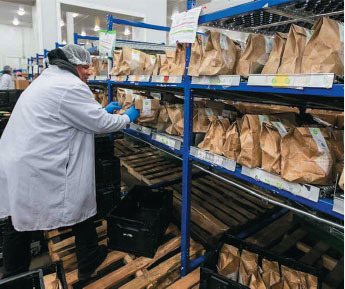Ergonomic Solutions Support Safer Handling At EASE Council Member Facilities

 With its new National Emphasis Program, the Occupational Safety and Health Administration’s (OSHA) will be scrutinizing warehousing and distribution operations’ ergonomic practices more closely. Facilities looking to address the causes of worker injuries can gather safer handling ideas from the members of the Ergonomic Assist Systems & Equipment (EASE) Council. In a recent MHI Solutions article, “Ergonomic Products Help Ensure Worker Safety,” EASE Council members shared how ergonomic solutions support safer handling — including in their own facilities.
With its new National Emphasis Program, the Occupational Safety and Health Administration’s (OSHA) will be scrutinizing warehousing and distribution operations’ ergonomic practices more closely. Facilities looking to address the causes of worker injuries can gather safer handling ideas from the members of the Ergonomic Assist Systems & Equipment (EASE) Council. In a recent MHI Solutions article, “Ergonomic Products Help Ensure Worker Safety,” EASE Council members shared how ergonomic solutions support safer handling — including in their own facilities.
In announcing the program, OSHA cited a lack of proper ergonomics among the most common hazards in warehousing and distribution. But, as one might expect, members of the EASE Council — whose mission includes improving the use and understanding of ergonomic solutions — practice safer handling across as many areas of their operations as possible.
Ergonomic applications actually extend far beyond industrial operations, explained Patrick Lippert, Director of Supply Chain for EASE Council member Hamilton Caster. “It’s not just out in the shop, but also in our daily lives,” he said, noting that ergonomic solutions deliver more than just safer handling. “These products make work safer, easier, and less stressful on the body.”
Lifting Technologies at Caster Manufacturer Support Safer Handling
Hamilton Caster, which manufacturers industrial wheels and casters that promote easier mobility of loads, uses a lifting system to protect workers’ backs. At the lathes used to machine the wheels, lifting devices raise, lower, and tilt crates of metal blanks. This makes selecting and loading the blanks into the machines easier on machinists.
“They can grab them from a safe and more ergonomic distance, so that they’re not bending over, and can lift them into the machines more easily,” Lippert noted. Additionally, workers wear lifting belts to further prevent back injuries.
Improving ergonomics was one motivation behind Hamilton Caster’s move to a new facility a few years ago. The building’s higher ceilings allowed the company to install overhead workstation cranes and lifting devices at every lathe. Leadership continues to assess workflows, looking for additional opportunities to further enhance ergonomics for safer handling.
“We’d love to get to a point where we could utilize crate or skid movers that are automated,” continued Lippert. The company is also evaluating robotic movement for time-consuming, repetitive material handling tasks.
Vacuum-Assisted Lifting Helps Minimize Injury Risks
 Overhead lift systems include vacuum-assisted devices such as the ones made by EASE Council member Schmalz. Their vacuum tube lifters work in tandem with overhead cranes like the ones in use at Hamilton Caster. By gripping and supporting the load while the operator guides its movement, the lifters eliminate repetitive stress to facilitate safer handling.
Overhead lift systems include vacuum-assisted devices such as the ones made by EASE Council member Schmalz. Their vacuum tube lifters work in tandem with overhead cranes like the ones in use at Hamilton Caster. By gripping and supporting the load while the operator guides its movement, the lifters eliminate repetitive stress to facilitate safer handling.
“Even with 20- or 30-pound boxes, turning your body and lifting on a repeat basis is a huge issue,” said Mark Westphal, Director of Marketing for Schmalz. Portable, the lifters can be moved to different areas of an operation as needed.
The lifters also allow one employee to do the work of two, he added. Not only does this reduce the need for tandem lifts, but also the challenges associated with industrial labor shortages.
Carton Flow Systems Minimize Bending and Reaching
 In addition to lifters, many manufacturing and piece picking operations also utilize carton flow racks. These ergonomic systems reduce reaching by presenting items at an optimal height. Carton flow racks also boost productivity through better organization, said Megan Baker, Director of Marketing at UNEX, which manufactures these systems.
In addition to lifters, many manufacturing and piece picking operations also utilize carton flow racks. These ergonomic systems reduce reaching by presenting items at an optimal height. Carton flow racks also boost productivity through better organization, said Megan Baker, Director of Marketing at UNEX, which manufactures these systems.
Often, operations install these solutions to boost productivity and streamline workflows. Safer handling through improved ergonomics is a side benefit, she noted.
“Having something better for the workers is a huge byproduct in implementing these solutions. In doing so, reducing strain on workers improves efficiency,” Baker said. “You may not be coming here and thinking about ergonomics as your number one pain point, but you’re making a huge difference for your bottom line.”
Get Implementation Inspiration from EASE Council Case Studies
In addition to the MHI Solutions article, the members of the EASE Council offer a library of nearly 50 different case studies on their website. Solutions for safer handling span a variety oof industries, including beverage, automotive, apparel, consumer goods, pharmaceuticals, construction materials and more.



